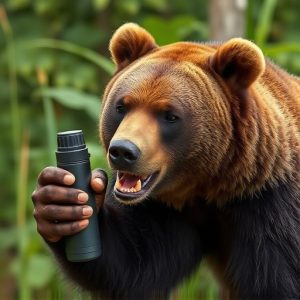Protecting Yourself: Comprehensive Guide to Defending Against Grizzly Bears
Understanding grizzly bear behavior is crucial for safe travel in areas with bear populations. The T…….
Understanding grizzly bear behavior is crucial for safe travel in areas with bear populations. The TSA allows carrying bear spray, adhering to specific rules regarding container size, concentration, and distance of deployment (20-30 feet). Effective usage involves aiming at the bear's face while maintaining calmness and avoiding sudden movements. Beyond bear spray, following TSA guidelines, understanding bear behavior, and using alternative deterrents like air horns or reflective gear enhance safety in bear country.
“Navigating the wilderness comes with unique challenges, especially when encountering one of nature’s most formidable predators—the grizzly bear. Understanding their behavior is key to survival. This article equips readers with essential knowledge on recognizing grizzly signals and triggers, alongside a deep dive into the Tsa Rules for Bear Spray—a crucial defense mechanism. We explore factors to consider when choosing the right spray, proper usage techniques, and additional safety measures beyond bear spray. By arming yourself with these tools, you can enhance your wilderness experience while ensuring maximum protection.”
- Understanding Grizzly Bear Behavior: Recognizing Signals and Triggers
- The TSA Rules for Bear Spray: What You Need to Know Before Heading Out
- Choosing the Right Bear Spray: Factors to Consider for Effective Protection
- Proper Usage Techniques: Ensuring Your Safety in a Face-to-Face Encounter
- Additional Measures: Beyond Bear Spray for Wilderness Safety
Understanding Grizzly Bear Behavior: Recognizing Signals and Triggers
Understanding Grizzly Bear Behavior is crucial when navigating their habitat, especially in areas where they are known to roam. Grizzly bears, or Ursus arctos horribilis, are powerful animals with complex social structures and survival instincts. Recognizing their behavior patterns can help hikers and outdoor enthusiasts avoid potentially dangerous encounters. One of the key aspects to watch for is the bear’s body language and vocalizations when they feel threatened or defensive.
Grizzly bears typically avoid human interaction unless they perceive a threat, such as food or cubs being endangered. They may display various signals, like huffing, jaw-popping, stomping their feet, or swatting at the ground, to communicate their discomfort or aggression. The Tsa Rules for Bear Spray emphasize the importance of carrying and using this deterrent as a last resort when facing an aggressive bear. Knowing these triggers can empower individuals to make safe decisions in bear country.
The TSA Rules for Bear Spray: What You Need to Know Before Heading Out
When preparing for a trip into wild areas known for grizzly bear populations, understanding the TSA rules for bear spray is vital. The Transportation Security Administration (TSA) has specific regulations regarding the transport of bear spray as a safety measure for air travelers and airport personnel. These rules dictate that bear spray canisters must be in an approved container, typically a hard-sided bag designed to prevent leakage or discharge during security checks.
The TSA allows passengers to carry bear spray if it complies with their guidelines. This includes using a canister no larger than 10 ounces (or 296 milliliters) and ensuring the safety mechanism is intact. It’s crucial to check the expiration date, as bear spray can lose its effectiveness over time. Proper storage and handling are key; always keep the container closed when not in use, and store it away from heat sources or direct sunlight.
Choosing the Right Bear Spray: Factors to Consider for Effective Protection
When selecting bear spray, understanding the TSA rules for bear spray is paramount. The Transportation Security Administration (TSA) allows travelers to carry bear spray in their checked baggage and as a hand luggage item, provided it meets specific criteria. Key factors to consider include the concentration of capsaicin (the active ingredient), the distance at which the spray can be effectively deployed, and the size and weight of the container. Opt for a product that contains at least 15% capsaicin, offers a range of 30 feet or more, and complies with TSA dimensions and weight restrictions.
Additionally, ensure the bear spray is designed for grizzly bears, as not all sprays are created equal. Look for products specifically formulated to deter aggressive predators like grizzlies, which have higher pain thresholds than black bears. Always check expiration dates and follow manufacturer instructions for proper usage and storage. Staying prepared with the right equipment can significantly enhance your safety when encountering a charging grizzly bear in the wilderness.
Proper Usage Techniques: Ensuring Your Safety in a Face-to-Face Encounter
In a face-to-face encounter with a grizzly bear, knowing how to properly use your bear spray is crucial according to the TSA Rules for Bear Spray. Aim for the bear’s face and eyes, as this is where the spray will have the most effect. Keep in mind that you need to activate and apply the spray from a safe distance, typically 20-30 feet away, to prevent inadvertently inhaling it yourself.
Remember, bear spray is a tool meant for deterrence, not elimination. If the bear doesn’t retreat after you’ve sprayed, it’s time to employ other defensive strategies, like making loud noises or using any available objects as a barrier between you and the bear. Always stay calm and avoid sudden movements, which could provoke an attack.
Additional Measures: Beyond Bear Spray for Wilderness Safety
When it comes to wilderness safety against charging grizzly bears, going beyond bear spray is crucial. While the TSA Rules for Bear Spray dictate its legal carrying and usage, there are additional measures that can significantly enhance your protection. Knowing and practicing specific behaviors designed to deter bears, such as making noise to avoid surprising them or maintaining a safe distance, is essential.
Having a robust understanding of bear behavior and habitats allows you to make informed decisions while in the wilderness. Carrying and knowing how to use alternative deterrents like air horns or bear bells can also be lifesaving. Additionally, wearing loud clothing and carrying bright, reflective gear increases your visibility, potentially startling bears and giving them time to retreat.
When venturing into wilderness areas known for grizzly bear habitats, equipping yourself with knowledge and the right tools is vital. Understanding bear behavior, familiarizing yourself with TSA rules on bear spray, and choosing the appropriate spray are essential steps for your safety. Additionally, learning proper usage techniques and considering other preventive measures can significantly reduce risks during encounters. By combining these strategies, you’ll be well-prepared to navigate through potential dangers, ensuring a safer outdoor experience. Remember, staying informed and proactive is key when it comes to defending yourself against charging grizzlies.


